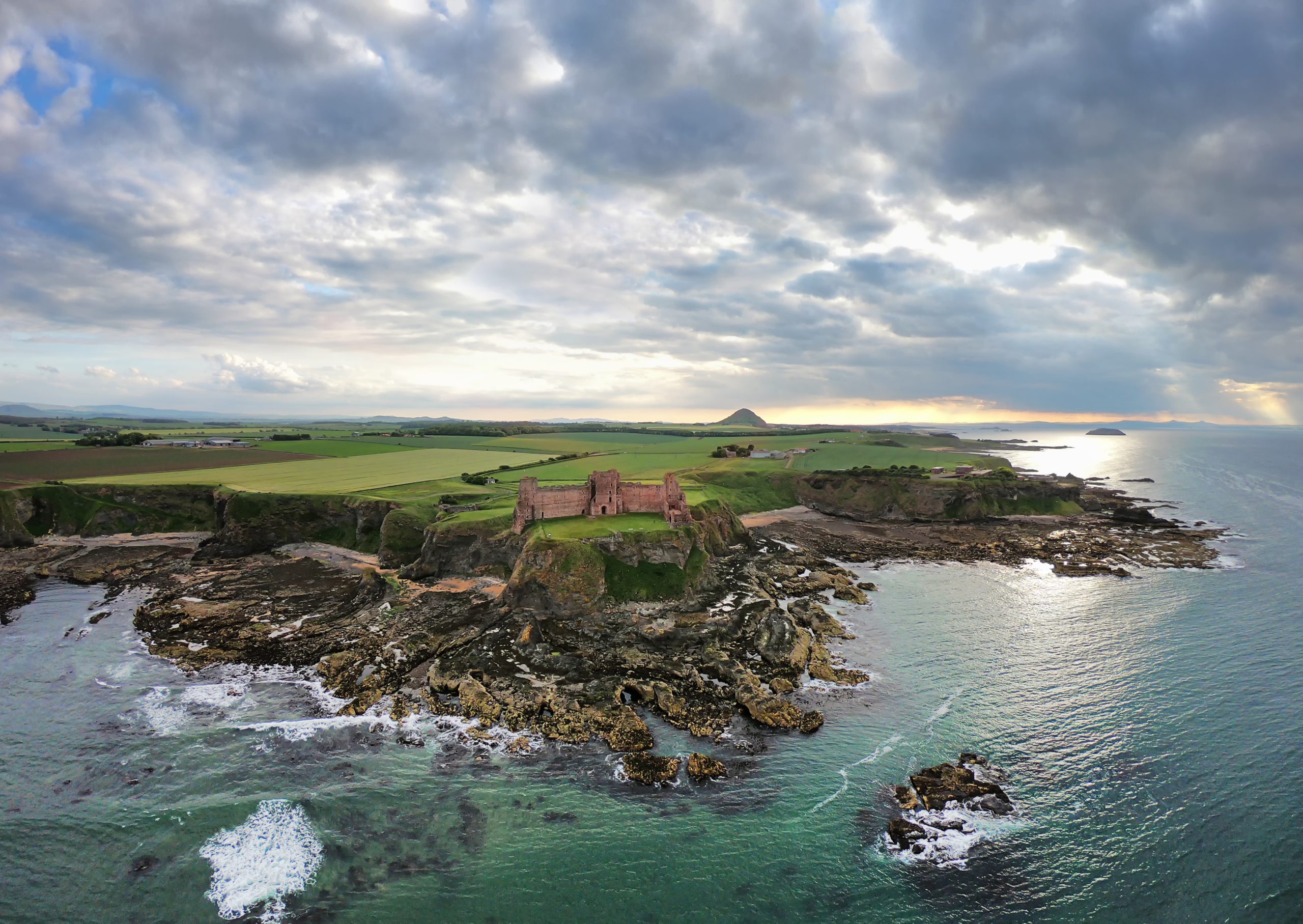The castle was originally built by William Douglas, 1st Earl of Douglas, and played a significant role in many of Scotland’s historical events. It was the last stronghold of the Douglas family during the Wars of Scottish Independence, and was later besieged by Oliver Cromwell’s forces during the English Civil War. Today, visitors can explore the castle’s many features, including its great hall, kitchens, and various chambers. The castle’s dramatic location and fascinating history make it a popular destination for tourists, history enthusiasts, and photographers alike.
History of Tantallon Castle
James IV and James V Reign
Tantallon Castle is a historic fortress located on the east coast of Scotland in East Lothian. The castle was built in the mid-14th century by William Douglas, 1st Earl of Douglas, and was later passed on to the Red Douglas dynasty. During the reigns of James IV and James V, the castle was an important stronghold for the Douglas family, who were one of the most powerful noble families in Scotland at the time.
Oliver Cromwell’s Siege
In 1651, Tantallon Castle was besieged by Oliver Cromwell’s army during the Wars of the Three Kingdoms. The castle was defended by the Red Douglas family, but they were eventually forced to surrender after a long and gruelling siege. The castle was badly damaged during the siege and was never fully restored to its former glory.
Red Douglas Dynasty
Architectural Features
Curtain Wall and Towers
Tantallon Castle’s most striking feature is its curtain wall, which stretches for over 500 meters around the castle. The wall is 3 meters thick and up to 12 meters high in some places, with several towers and turrets rising above it. The towers are cylindrical in shape and have conical roofs. They were designed to provide a clear line of sight in all directions so that defenders could spot any approaching enemies.
The Great Hall
The Great Hall is the largest room in Tantallon Castle and was used for banquets, meetings, and other important events. It is located on the first floor of the tower house and is accessed via a spiral staircase. The hall is 14 meters long and 6 meters wide, with a large fireplace and a high ceiling. The walls are adorned with ornate carvings and paintings.
Pit Prison and Gun Room
Location and Views
Tantallon Castle is located on the East Lothian Coastline, just outside the town of North Berwick. The castle is situated on a cliff overlooking the North Sea, providing visitors with breathtaking views of the surrounding area.
The North Sea and Bass Rock
One of the most impressive features of Tantallon Castle is the view of the North Sea and Bass Rock. The North Sea is a vast body of water that stretches from the coast of Norway to the east of Scotland. The sea is home to a wide variety of marine life, including dolphins, whales, and seals. Bass Rock is a small island located in the Firth of Forth, just off the coast of North Berwick. The island is home to a large colony of gannets, making it a popular spot for birdwatchers.
East Lothian Coastline
Visiting Tantallon Castle
Tantallon Castle is a magnificent fortress located in East Lothian, Scotland. If you’re planning to visit this historic site, here’s what you need to know:
Visitor Access and Restrictions
Tantallon Castle is open to visitors throughout the year, except on Christmas Day and Boxing Day. The castle is open from 9:30 am to 5:30 pm in the summer months, and from 10 am to 4 pm in the winter months. The last entry is 30 minutes before closing time.
Visitors can access most parts of the castle, including the ramparts, which offer stunning views of the surrounding area. However, some areas of the castle may be closed off due to maintenance or safety reasons.

DCIM100GOPROGOPR0427.JPG
Booking Tickets
Visitors can purchase tickets to Tantallon Castle on the Historic Environment Scotland website or at the entrance to the castle. If you book your tickets online, you can save money and skip the queue at the entrance.
Attractions and Tours
Tantallon Castle offers a range of attractions and tours that visitors can enjoy. Information boards are located throughout the castle, providing visitors with information about the castle’s history and architecture.
Visitors can also take part in a fact-finding quiz, which is a fun way to learn more about the castle’s history. The quiz is suitable for all ages and is available at the entrance to the castle.
There are no restaurants or cafes at Tantallon Castle, but visitors are welcome to bring their own food and drinks. Picnic tables are available in the castle grounds, providing visitors with a place to rest and enjoy the scenery.
Conservation and Management
Historic Scotland
Tantallon Castle is a scheduled monument and is managed by Historic Scotland. Historic Scotland is responsible for the conservation, repair, and maintenance of the castle. They also manage the visitor experience and provide interpretation and education services.
Historic Environment Scotland
In 2015, Historic Scotland merged with the Royal Commission on the Ancient and Historical Monuments of Scotland to form Historic Environment Scotland (HES). HES is now responsible for the management of Tantallon Castle, including its conservation, repair, and maintenance.
English Heritage
English Heritage is not involved in the management or conservation of Tantallon Castle as it is located in Scotland. However, English Heritage has a similar role in managing historic sites in England.
Cadw
Cadw is the Welsh Government’s historic environment service. They are not involved in the management or conservation of Tantallon Castle as it is located in Scotland. However, Cadw has a similar role in managing historic sites in Wales.
Conservation work is ongoing at Tantallon Castle, and the castle is regularly monitored to ensure its structural integrity. The conservation work includes repairs to the stonework, consolidation of the walls, and the removal of vegetation that may damage the castle. The castle’s surroundings are also managed to preserve the natural and cultural heritage of the site.
Tantallon Castle in Popular Culture
Under the Skin
Tantallon Castle has been featured in a number of popular culture works, including the 2013 science fiction film “Under the Skin” directed by Jonathan Glazer. The film stars Scarlett Johansson as an alien who preys on men in Scotland, and Tantallon Castle serves as the backdrop for one of the film’s most memorable scenes.
In the film, Johansson’s character lures a man into the castle ruins and ultimately consumes him. The haunting beauty of the castle and its dramatic cliffside location make for a perfect setting for the eerie and unsettling atmosphere of the film.
The castle’s appearance in “Under the Skin” has helped to bring attention to the historic site, and visitors can now explore the castle ruins and imagine the chilling events of the film taking place within its walls.
Wildlife at Tantallon Castle
Tantallon Castle is not only a historic landmark, but it is also a natural habitat for various species of wildlife. The castle is located on a cliff overlooking the North Sea, providing a unique environment for both land and sea creatures.
Seabird Colonies
One of the most notable wildlife attractions at Tantallon Castle is the seabird colonies. The castle’s location on the cliff provides a perfect nesting ground for various species of seabirds. Visitors can observe colonies of gannets, guillemots, kittiwakes, and razorbills from the castle walls. The seabirds can be seen flying in and out of their nests, diving into the sea to catch fish, and resting on the rocks below.
Birds
Apart from the seabirds, Tantallon Castle is also home to other bird species. Visitors can spot peregrine falcons, kestrels, and buzzards soaring above the castle walls. The castle’s ruins provide an ideal habitat for these birds of prey, allowing them to hunt for food and roost in the castle’s nooks and crannies.
Other Wildlife
Tantallon Castle’s location on the cliff provides a unique environment for land-based wildlife as well. Visitors can spot rabbits, hares, and other small mammals scurrying around the castle’s grounds. The castle’s walls and ruins also provide shelter for various insects and spiders.

